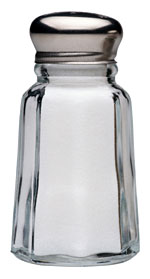 Even the most dedicated health nut likes to go out on the town and grab a bite at a good restaurant. But that’s often fraught with dietary land mines. Every patron is fighting a losing battle with all the salt that restaurants add to their cuisine.
Even the most dedicated health nut likes to go out on the town and grab a bite at a good restaurant. But that’s often fraught with dietary land mines. Every patron is fighting a losing battle with all the salt that restaurants add to their cuisine.
According to the consumer watchdog group the Center for Science in the Public Interest, restaurants are increasing their customers’ chances of high blood pressure, heart attack, and stroke with all the salt they add to their food.
Among 10 popular chain restaurants examined, about 85 percent of the adult meals have more than the recommended daily sodium intake (which is >2,300 mg). Here are some examples given:
- Red Lobster’s Admiral’s Feast at 7,106 milligrams of sodium. The meal includes lobster, Caesar salad with dressing, lobster-topped mashed potato, biscuit, and lemonade.
- Chili’s Buffalo Chicken Fajitas and a Dr. Pepper at 6,916 milligrams of sodium.
- Chili’s Honey Chipotle Ribs at 6,440 milligrams of sodium, which includes mashed potatoes with gravy, seasonal vegetables, and Dr Pepper.
- Olive Garden Tour of Italy lasagna at 6,176 milligrams of sodium, with a bread stick, salad with house dressing, and a Coca-Cola.
- Olive Garden Chicken Parmigiana at 5,735 milligrams of sodium, with breadstick, salad with house dressing, and raspberry lemonade.

The watchdog group also identified five kids’ meals containing more than twice the recommended daily sodium intake for kids (1,200 mg) in a single meal.
- Red Lobster Chicken Fingers, biscuit, fries, and raspberry lemonade, at 2,430 milligrams of sodium.
- Chili’s Country Fried Chicken Crispers with rice and 1% milk at 2,385 milligrams of sodium.
- KFC Popcorn Chicken with macaroni and cheese, Teddy Grahams, and 2% milk at 2,005 milligrams of sodium.
- Jack in the Box Grilled Chicken Strips, Buffalo Sauce, fries, and 1% milk at 1,980 milligrams of sodium.
- Olive Garden Chicken Fingers, fries, and raspberry lemonade at 1,835 milligrams of sodium.
“These chains are sabotaging the food supply. They should cut back and give consumers the freedom to decide for themselves how much salt they want,” says Michael F. Jacobson, executive director of the Center for Science in the Public Interest.
The Center for Science in the Public Interest petitioned the FDA in 2005 to regulate the amount of salt in the U.S. food supply. But Beth Johnson, executive vice president of the National Restaurant Association, says that her industry has made “tremendous strides” in the sodium content of restaurant food.
Unless there’s some sort of miraculous breakthrough, and restaurants either voluntarily reduce sodium or are forced to, the best you can do is moderate the number of times you dine out and research menus on the Internet.
(via: WebMD)
